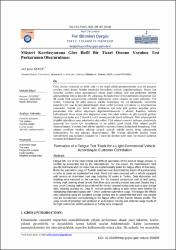Müşteri Korelasyonuna Göre Hafif Bir Ticari Otonun Yorulma Test Parkurunun Oluşturulması
Abstract
Ürün tasarım sürecinde en kritik olan ve zor tespit edilen parametrelerden olan bir parçanın
yorulma ömrü, üretici firmalar tarafından hızlandırıcı testlerle doğrulanmaktadır. Bunun için
üreticiler yorulma etkisi matematiksel olarak tespit edilmiş özel test parkuruna ve/veya
güzergahlarına ihtiyaç duyarlar. Bu çalışmada, hızlandırılmış bir test parkurunu oluşturmak için
ilk olarak Türk müşterilerinin otomobil kullanımları anket yöntemi ile tespit edilmiştir. Yol
testleri, Türkiye'de 50 şehri içerecek şekilde belirlenmiş bir yol haritasında, sensörlerle
donatılmış bir araç ile gerçekleştirilmiştir. Ham veriler üzerinde veri işleme ve detaylandırma
yapılmıştır. Yaprak yay, tahrik mili, direksiyon rod kolu gibi gerilme meydana gelen
parçalardan elde edilen sinyallerin değerlendirilmesinde 3 eksenli Rainflow metodu
kullanılmıştır. Buna karşın vites değiştirme oranı, fren adedi miktarı vb. gibi üzerinde gerilme
oluşmayan parçalar için 2 eksenli Level-Crossing metodu tercih edilmiştir. Türk müşteri profili
sinyaller işlendikten sonra anketlerden elde edilen Türk müşteri otomotiv kullanım yüzdeleriyle
çarpılarak her sensör için hesaplanmış ve bu şekilde genel olarak Türk müşteri profili
oluşturulmuştur. Yorulma ömrü etkileri ağırlıklı ortalama yöntemi kullanılarak hesaplanıp, Türk
müşteri profilinin yorulma etkisine karşılık gelecek şekilde üretici firma yakınlarında
hızlandırılmış bir test parkuru oluşturulmuştur. Bir Avrupa ülkesinde üretilen binek
otomobillerin araç kullanım sonuçları ve Türkiye'de üretilen hafif ticari oto müşteri kullanım
sonuçları karşılaştırılmıştır. Fatigue life, one of the most critical and difficult parameters of the product design process, is
verified by accelerated test by the manufacturers. For this reason, the manufacturers need
specific test tracks and / or routes that are mathematically tested for fatigue effect. In this study,
firstly the automotive usage of Turkish customers was determined by means of questionnaires
in order to create an accelerated test track. Road tests were executed with a vehicle equipped
with sensors on determined road map including 50 routes in Turkey. Data elaboration and
detailing were executed on the raw data. For the stressed components such as leaf spring,
driving shaft, steering wheel tie rod, Rain-flow cycle counting method was used. Despite that 2
axes Level-Crossing method was preferred for the non stressed components such as gear change
ratio, breaking quantity etc. Data of mission profile belong to each sensor were handled by
multiplying elaborated signals with Turkish customer automotive usage. The fatigue life effects
were calculated using the weighted average method and an accelerated test track was created
near the manufacturer corresponding to the fatigue effect of the Turkish mission profile. The
usage results of passenger cars produced in an European country and costumer usage results of
the light commercial vechile produced in Turkey were compared.

















